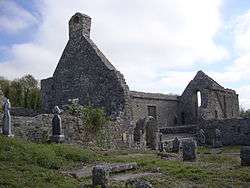Killone
Killone (Irish: Cill Eoin[1]) is a civil parish of County Clare, Ireland, to the southwest of Ennis. It is known for the ruins of Killone Abbey.
Killone Cill Eoin | |
|---|---|
Civil parish | |
 | |
 Killone Location in Ireland | |
| Coordinates: 52°47′57″N 8°59′54″W | |
| Country | Ireland |
| Province | Munster |
| County | County Clare |
| Time zone | UTC+0 (WET) |
| • Summer (DST) | UTC-1 (IST (WEST)) |
Location
Killone is in the Barony of Islands, 2.5 miles (4.0 km) southwest of Ennis on the road to Kildysart.[2] It is 1 mile (1.6 km) southwest of Clareabbey. The parish is 3.75 by 3.25 miles (6.04 by 5.23 km) and covers 5,718 acres (2,314 ha). The parish covers most of the western screen of the head of the River Fergus estuary, and combines fertile low ground with rocky hillocks, hills, and ridges. The parish holds Killone Lough.[3]
Antiquities
Domnall Mór Ua Briain, styled King of Limerick, founded Killone Abbey around 1190 for Augustinian nuns, dedicated to Saint John the Baptist. Slaney, daughter of King Donogh Carbreach of Thomond, was abbess of this nunnery. She died in 1260.[4] The ruins are near the northeast of Lake Killone.[2] Killone Abbey is linked to Clare Abbey by the Pilgrim's road, a footpath.[5] There is a holy well dedicated to Saint John near the abbey.[2]
In 1544 King Henry VIII of England granted the abbey, three townlands, all the tithes of the parish of Killone and much other property in Clare to Murrough O'Brien, 1st Earl of Thomond. In 1580 Killone Castle was the property of the Baron of Inchiquin. There is now no trace of the castle.[4]
As of 1837 the parish was united with the Clareabbey parish in the Catholic church.[6] There was a chapel at Ballyea.[2] The population in 1841 was 2,777 in 429 houses.[3] The civil parish is now part of the Ballyea/Clarecastle Catholic parish. Mass is still held at Saint John's Well.[5]
Townlands
Townlands are Ballyea, Ballyvullagan, Bansha, Barloughra, Barnanageeha, Cappagarraun, Darragh North, Darragh South, Drumadrehid, Drummeen East, Drummeen West, Edenvale, Kilglassy, Killerk East, Killerk West, Kilmoraun, Kilmore, Knockanira, Lackennaskagh, Lismulbreeda, Newhall, Rathmeehan, Reaghfa, Shannacool and Teermaclane.[7]
References
Citations
Sources
- "Cill Eoin". Placenames Database of Ireland. Retrieved 11 April 2014.
- Frost, James (1897). "Ui Cormaic, Killone Parish". The History and Topography of the County of Clare. Retrieved 4 April 2014.CS1 maint: ref=harv (link)
- Lewis, Samuel (1837). A topographical dictionary of Ireland. 2. Lewis. Retrieved 4 April 2014.CS1 maint: ref=harv (link)
- Lewis, Samuel (1840). A topographical dictionary of Ireland: comprising the several counties, cities, boroughs corporate, market, and post towns, parishes and villages ... : With an appendix describing the electoral boundaries of the several boroughs as defined by the act of the 2d. and 3d. of William IV. 1. Lewis. Retrieved 4 April 2014.CS1 maint: ref=harv (link)
- "Map of Killone Parish showing Townlands". Clare County Library. Retrieved 4 April 2014.
- "Mass at St John's Well – a very special occasion". Clarecastle Community Development. 23 June 2013. Retrieved 4 April 2014.
- "Killone". Parliamentary Gazetteer of Ireland. 1845. Retrieved 4 April 2014.